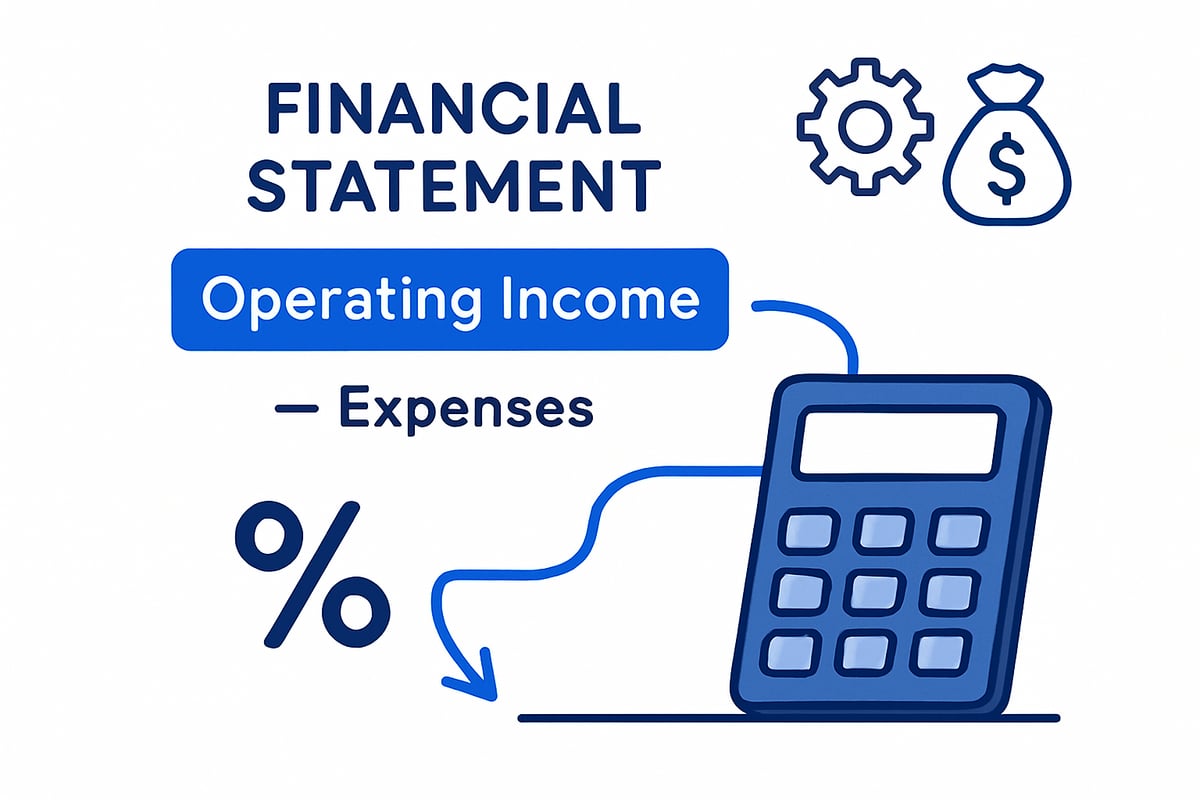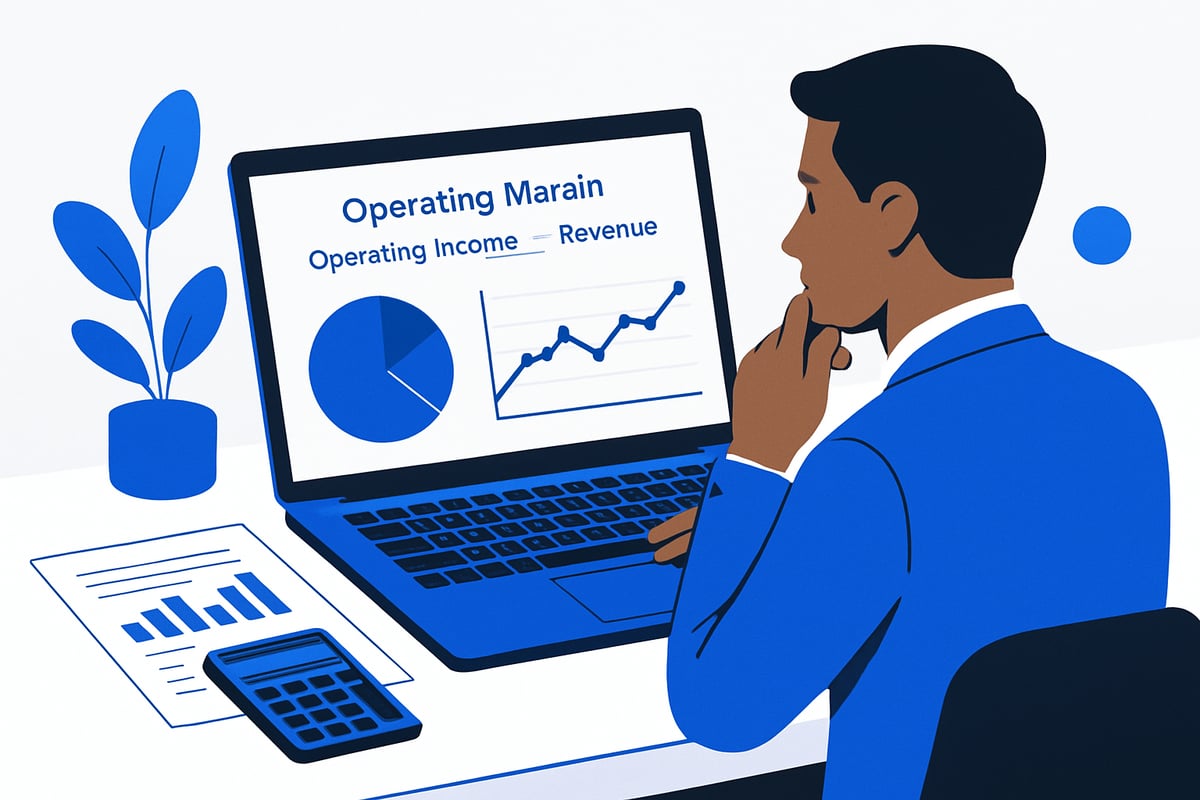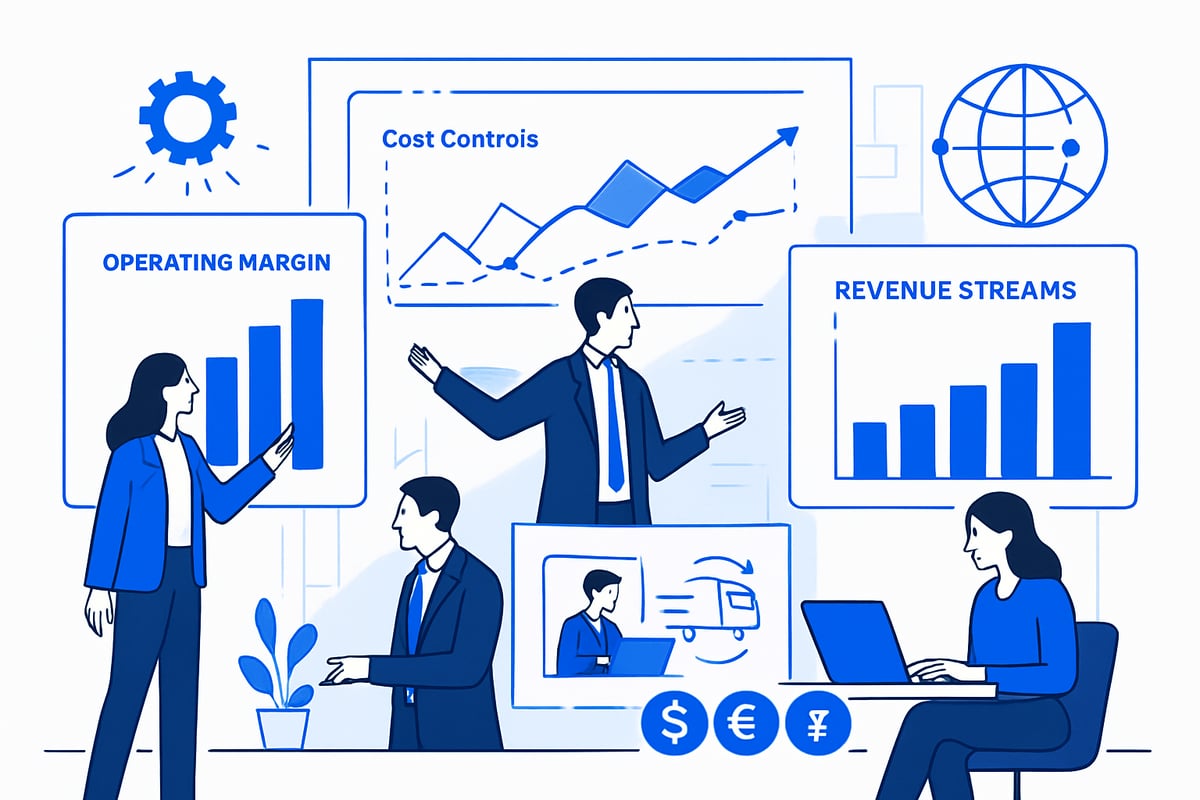Operating Margin Guide: Strategies for 2025 Success
In today’s fast-paced business world, understanding your operating margin is more critical than ever. This key metric reveals how efficiently your company turns revenue into profit from core operations, setting industry leaders apart from the rest.
This guide is designed to simplify operating margin, showing you actionable ways to improve it and highlighting the trends shaping profitability in 2025. We will break down the essentials, provide calculation steps, and offer proven strategies to help your business thrive.
Discover why top companies focus on operating margin, learn to transform your financial health, and get ready to take action for success in 2025.
Understanding Operating Margin: The Fundamentals
Grasping the fundamentals of operating margin is essential for making informed business decisions in today's evolving market. Also known as operating income margin, EBIT margin, or return on sales (ROS), this metric measures a company's core profitability from its primary operations, before accounting for interest and taxes. By zeroing in on the relationship between operating income and revenue, operating margin reveals how efficiently a business converts sales into operating profit.

The Operating Margin Formula and Example
The core formula for operating margin is straightforward:
Operating Margin = (Operating Income / Revenue) x 100%
For example, if a company like Coca-Cola reports $10.3 billion in operating income and $32.8 billion in revenue, its operating margin would be:
Operating Margin = ($10.3B / $32.8B) x 100% = 31.45%
This percentage shows that Coca-Cola retains 31.45 cents in operating profit for every dollar of revenue generated.
Distinguishing Operating Margin from Other Metrics
While operating margin gauges operational efficiency, it is different from other profitability ratios. Here’s a quick comparison:
| Metric | What It Measures | Includes/Excludes |
|---|---|---|
| Operating Margin | Profit from core operations | Excludes interest, taxes |
| Net Profit Margin | Bottom-line profit | Includes all expenses |
| Gross Margin | Profit after cost of goods sold | Excludes operating expenses |
| EBITDA Margin | Earnings before interest, taxes, D&A | Excludes depreciation, amortization |
Understanding these differences allows you to select the metric best suited to your analysis.
Why Operating Margin Matters
Operating margin is a vital indicator of a company's ability to manage core business costs and maximize revenue. Investors and analysts use this metric to assess how well management controls expenses, especially in comparison with competitors. A strong operating margin signals robust operational health, providing a buffer against market downturns and unexpected costs.
Efficient cost control and revenue optimization directly impact operating margin, reflecting management's effectiveness. Companies with consistently high operating margins tend to exhibit disciplined expense management and strategic pricing.
Key Terms and Common Misconceptions
Several key terms are essential for understanding operating margin:
- Operating Income: Earnings from regular business activities, minus operating expenses.
- Revenue: Total sales from goods or services.
- Variable Costs: Expenses that change with production volume.
- Fixed Costs: Expenses that remain constant regardless of output.
If you need more clarity on these financial terms, the Key finance terms glossary provides concise definitions.
Common misconceptions include confusing operating margin with net profit margin or overlooking the impact of non-operating items. Another pitfall is failing to consider industry norms—some sectors naturally operate on lower margins due to higher competition or input costs.
A solid grasp of operating margin lays the groundwork for deeper financial analysis and more effective business strategy.
The Strategic Importance of Operating Margin in 2025
Understanding the strategic importance of operating margin is vital for business leaders aiming to thrive in 2025. As economic pressures mount and competition intensifies, operating margin stands out as a guiding metric for operational decision-making and long-term planning.

The Role of Operating Margin in Decision-Making
Operating margin is more than a number—it is a powerful lens through which businesses evaluate their core activities. By focusing on this metric, companies can make informed choices about capital allocation, pricing strategies, and resource management. A healthy operating margin signals operational efficiency and enables leaders to allocate resources where they drive the most value.
Management teams rely on operating margin to identify profit drivers and cost centers. This clarity supports better budgeting, smarter investments, and proactive adjustments to changing market conditions.
Operating Margin in Investor and Analyst Evaluations
Investors, analysts, and lenders closely monitor operating margin when assessing a company’s financial health. Unlike net profit margin, operating margin strips out interest and taxes, offering a clearer view of a company’s core operating performance. A strong operating margin demonstrates effective cost control and revenue generation, making the business more attractive to stakeholders.
Shareholder value is often linked to consistent and improving operating margin. When this metric rises, it can boost company valuations and signal robust management practices. Conversely, declining operating margin may raise red flags about inefficiencies or competitive pressures.
Industry Variations and Emerging Trends
Operating margin expectations are not universal. For example, technology companies typically report higher margins than retailers or manufacturers due to differences in cost structures and business models. The table below highlights average operating margins across major sectors:
| Industry | Average Operating Margin (%) |
|---|---|
| Technology | 20–30 |
| Retail | 5–10 |
| Manufacturing | 10–15 |
| Services | 15–20 |
Recent years have brought new challenges and opportunities. Inflation, supply chain disruptions, and digital transformation are reshaping margin dynamics. Companies investing in automation and analytics are finding ways to protect or even expand their operating margin despite external headwinds. For actionable insights and emerging approaches, see this Profit Margin Growth Strategies for 2025 guide.
Benchmarking for 2025 Success
Benchmarking your operating margin against industry peers is essential. It reveals strengths, exposes weaknesses, and uncovers opportunities for improvement. Global standards and public filings provide valuable reference points, helping companies set realistic, data-driven goals.
A recent survey found that 69% of senior marketing managers consider return on sales—a synonym for operating margin—“very useful” for strategic planning and performance evaluation. This statistic underscores the widespread reliance on this metric as a predictor of resilience and growth.
In 2025 and beyond, mastering your operating margin is a critical lever for sustainable profitability and competitive advantage. Use it as a compass to navigate market volatility and ensure your business remains on the path to success.
Step-by-Step Guide: How to Calculate and Analyze Operating Margin
Understanding how to calculate and analyze operating margin gives your business a competitive edge. By following a systematic approach, you can accurately assess your operational profitability, spot trends, and make data-driven decisions. This step-by-step guide will help you master the process, avoid common mistakes, and benchmark your operating margin performance. Each step is crucial for gaining actionable insights and sustaining profitability as you prepare for 2025.

1. Gather the Right Financial Data
Begin by collecting accurate and up-to-date financial statements. Focus on your income statement, as this document provides both revenue and operating income.
- Locate your total revenue, which is the top-line figure before expenses.
- Identify operating income, typically found after subtracting operating expenses from gross profit.
- Adjust for non-operating items, such as interest, one-time gains or losses, and taxes.
- Account for depreciation and amortization if they are included within operating expenses.
In more complex organizations, precise overhead allocation is essential. Misallocating shared costs can distort your operating margin and lead to misinformed decisions.
For example, let’s say Company A reports $2,000,000 in revenue and $600,000 in operating income. These are the core figures you will use in your calculation. Review financial notes for any adjustments that may affect these numbers, ensuring your operating margin reflects true operational performance.
2. Apply the Operating Margin Formula
With the right data in hand, apply the operating margin formula:
Operating Margin = Operating Income / Revenue
Express the result as a percentage for easy comparison. Using the Company A example:
Operating Margin = $600,000 / $2,000,000 = 0.30 or 30%
A 30% operating margin means that for every dollar earned, $0.30 remains after covering operating expenses. This ratio highlights how efficiently your business turns revenue into operating profit. Repeat this calculation for different periods to monitor progress.
When presenting results, use tables to compare year-over-year margins or segment performance. This clarity helps stakeholders quickly spot trends and make informed decisions.
3. Interpret Your Results
Interpreting your operating margin goes beyond the number itself. A high margin suggests robust operational efficiency, while a low or declining margin may signal cost pressures or revenue challenges.
Watch for warning signs such as rapidly shrinking margins or volatile swings, which could indicate operational inefficiencies or market shifts.
Context matters. Compare your margin to similar businesses and industry norms. For a deeper dive into how operating margin stacks up against other financial metrics, see Understanding quick ratio vs. margins, which clarifies how various ratios provide different perspectives on financial health.
4. Compare Against Benchmarks and Peers
Benchmarking your operating margin is vital for understanding where you stand. Public company filings, analyst reports, and industry databases offer reliable margin benchmarks.
Use this data to:
- Identify leaders and laggards in your sector
- Spot competitive advantages or weaknesses
- Inform strategic planning
Comparing operating margin across leading companies can reveal best practices and highlight areas for improvement within your own operations.
5. Track Margin Trends Over Time
Tracking operating margin trends year-over-year provides critical insights. Use financial dashboards or spreadsheets to visualize margin performance.
Look for inflection points, such as sudden increases or decreases, and investigate the underlying causes. Longitudinal analysis can uncover patterns that one-off calculations miss, helping you anticipate challenges and seize opportunities.
Consistently monitoring your operating margin equips you to adapt swiftly and maintain profitability, even as market dynamics evolve.
Key Drivers and Challenges Impacting Operating Margin in 2025
Understanding the forces shaping operating margin in 2025 is essential for any business leader aiming for sustainable profitability. The landscape is shifting rapidly, and both external pressures and internal decisions will play a pivotal role in determining your success.

Revenue Growth vs. Cost Control
Balancing revenue growth with disciplined cost management is at the heart of operating margin improvement. Companies that expand sales without controlling expenses may see their operating margin erode. Conversely, aggressive cost cuts can harm innovation or customer experience.
The optimal approach aligns revenue expansion with targeted efficiency gains. For example, a manufacturer might invest in automation to reduce labor costs while launching premium products to boost sales. This dual focus helps protect operating margin even when market conditions become volatile.
Rising Input Costs and Inflationary Pressures
Inflation, rising wages, and persistent supply chain disruptions are squeezing margins across industries. Raw material costs have surged, and many businesses are struggling to pass these increases onto customers. In 2025, monitoring input cost trends and renegotiating supplier contracts will be vital for maintaining a healthy operating margin.
A recent survey found that over 60% of executives expect input cost volatility to be a top challenge for the next year. Companies must prepare for fluctuating expenses and build flexibility into their sourcing strategies.
Technology Investments as Margin Levers
Investing in technology can act as a powerful lever for operating margin. Automation, artificial intelligence, and advanced analytics enable smarter decision-making and operational efficiencies. Digital transformation initiatives, such as implementing ERP systems or automating repetitive tasks, can lower overhead and free up resources for growth.
However, these investments require upfront capital and cultural change. Businesses that successfully integrate technology often realize both immediate savings and long-term competitive advantages.
Regulatory, Tax, and Globalization Challenges
Regulatory and tax changes can significantly impact operating margin. New compliance requirements, environmental standards, or tax laws may increase operational costs. Companies operating globally must also manage currency fluctuations and adapt to shifting trade policies.
Globalization brings both opportunities and risks. While accessing new markets can drive revenue, exposure to geopolitical instability and exchange rate volatility can compress operating margin if not managed proactively.
Shifting Consumer Preferences and Pricing Power
Consumer behavior is evolving rapidly. Demand for sustainable products, digital experiences, and personalized services is rising. Businesses with strong pricing power can better protect their operating margin by adjusting prices in response to cost increases.
However, not all industries enjoy the same flexibility. Commoditized sectors may struggle to pass on costs, while brands with loyal customers and differentiated offerings have more options.
Real-World Company Responses and Margin Trends
Leading organizations are responding to these challenges with innovative strategies. Some are leveraging data analytics to identify margin improvement opportunities, while others are focusing on product mix optimization and smart pricing. For a deeper dive into actionable tactics, explore Building a Higher Margin Business in 2025, which outlines how companies are adapting their strategies to sustain and grow operating margin in a dynamic environment.
Below is a snapshot of margin pressures and drivers shaping 2025:
| Driver/Challenge | Impact on Operating Margin |
|---|---|
| Revenue Growth | Positive if costs controlled |
| Input Cost Increases | Negative if not offset |
| Technology Investments | Positive with right adoption |
| Regulatory Changes | Can be negative or positive |
| Consumer Preferences | Depends on pricing power |
| Globalization | Mixed, increases complexity |
In summary, defending and improving operating margin in 2025 requires a multifaceted approach. By understanding and addressing these drivers and challenges, businesses can build resilience and position themselves for long-term success.
Proven Strategies to Boost Operating Margin for 2025 Success
Unlocking a higher operating margin in 2025 requires both vision and discipline. The most successful companies blend cost efficiency with innovation, continually adapting to market shifts. Below, explore actionable strategies to optimize your operating margin and fuel sustainable growth.
1. Streamline Operations and Reduce Costs
Streamlining day-to-day operations is foundational for improving your operating margin. Begin by identifying inefficiencies and areas of waste across the organization.
- Implement lean management practices to eliminate redundant processes.
- Leverage outsourcing for non-core functions to cut fixed costs.
- Automate repetitive tasks using digital tools and robotic process automation.
- Renegotiate supplier contracts for better terms.
For a deeper dive, the Strategies to Improve Operating Margins and Financial Resilience article presents proven cost reduction tactics, especially relevant for complex sectors like healthcare.
2. Enhance Revenue Quality and Pricing Power
Boosting your operating margin is not just about cutting costs, but also elevating revenue quality. Focus on selling higher-margin products and services.
- Optimize your product mix to feature offerings with superior profitability.
- Use dynamic and value-based pricing models to reflect customer willingness to pay.
- Segment your customer base to prioritize the most profitable segments.
- Regularly review pricing strategies to respond to market changes.
Analyzing customer data and closely monitoring competitor pricing can reveal untapped revenue opportunities that directly influence your operating margin.
3. Invest in Technology and Process Innovation
Technology is a powerful enabler for operating margin improvement. Strategic investments in digital solutions can transform efficiency and decision-making.
- Adopt ERP systems to streamline workflows and enhance data accuracy.
- Integrate artificial intelligence and analytics for smarter forecasting.
- Use automation tools to reduce manual errors and accelerate processes.
For comprehensive insights, see Maximizing Profit Margins: A Comprehensive Guide for 2025 and Beyond for practical ways AI and automation are reshaping operating margin optimization.
4. Improve Overhead Allocation and Expense Management
Accurate overhead allocation is critical for gaining a true picture of your operating margin. Misallocated costs can distort profitability analysis.
- Conduct regular expense audits to identify unnecessary spending.
- Apply zero-based budgeting to challenge all cost assumptions.
- Allocate indirect costs proportionally to the business units that generate them.
By tightening expense management, companies gain clearer visibility into what truly drives or erodes their operating margin.
5. Foster a Margin-Focused Culture
A margin-focused culture empowers teams to make decisions aligned with profitability goals. Leadership must set clear expectations and align incentives.
- Link employee bonuses and KPIs to operating margin targets.
- Provide ongoing training on cost awareness and efficiency.
- Encourage cross-departmental collaboration to surface new margin opportunities.
When everyone is invested in the same outcome, operating margin improvements become part of daily business practice.
6. Monitor and Adapt to External Market Forces
External factors can have a dramatic impact on your operating margin. Resilient companies anticipate and respond quickly to change.
- Use scenario planning to prepare for inflation or supply chain disruptions.
- Monitor regulatory and tax developments that affect operational costs.
- Stay agile and adjust business models as customer preferences evolve.
Regularly benchmarking your operating margin against industry peers also ensures you remain competitive, even in turbulent times.
Operating Margin Benchmarks, Best Practices, and Real-World Examples
Understanding how your operating margin stacks up against industry benchmarks is essential for evaluating your business’s financial health. Companies across different sectors report varying margins due to unique cost structures, competitive pressures, and market dynamics. Benchmarking your operating margin helps you set realistic goals and identify areas for improvement.
Industry Benchmarks: How Does Your Operating Margin Compare?
Industry averages provide a baseline for assessing your own operating margin. For example, technology companies often report higher margins due to scalable software models, while retail businesses typically operate with slimmer margins given their high volume and lower price points. Here’s a snapshot of average operating margins by sector:
| Industry | Average Operating Margin (%) |
|---|---|
| Technology | 20–30 |
| Healthcare | 15–25 |
| Manufacturing | 10–20 |
| Retail | 3–7 |
| Utilities | 12–18 |
Reviewing these benchmarks helps you understand if your operating margin is above or below the standard in your field. Comparing to sector peers can highlight competitive advantages or signal the need for operational changes.
Real-World Examples: Lessons from Margin Leaders
Examining companies with consistently strong operating margins reveals valuable strategies. For instance, Apple and Microsoft regularly post margins above 30 percent, reflecting both efficient operations and strong pricing power. In the beverage industry, Coca-Cola’s operating margin of 31.45 percent demonstrates the power of brand strength and global scale.
On the other hand, some retailers operate with margins closer to 5 percent. Their success depends on optimizing supply chains and leveraging high sales volumes to compensate for lower per-unit profitability. These examples underscore that achieving a robust operating margin requires both industry context and strategic execution.
Best Practices for Sustaining a Healthy Operating Margin
To maintain or improve your operating margin, focus on these proven best practices:
- Continuously monitor costs and identify savings opportunities.
- Invest in automation and digital transformation to drive efficiency.
- Regularly review your product mix to prioritize high-margin offerings.
- Benchmark against both direct competitors and broader industry averages.
- Align your financial analysis with other metrics, such as the debt-to-equity ratio explained, to ensure a holistic view of financial health.
Embedding these practices into your routine allows your business to adapt quickly to economic shifts and maintain a competitive edge.
Tools & Resources for Benchmarking Operating Margin
Access to reliable data is key for effective benchmarking. Public company filings, analyst reports, and financial databases such as Bloomberg or Morningstar offer valuable insights. Many organizations also use dashboards and visualization tools to track operating margin trends over time and compare them with industry standards.
Utilizing these resources helps you identify performance gaps and set data-driven targets for improvement.
Common Pitfalls in Margin Benchmarking
While benchmarking is invaluable, it’s important to avoid common mistakes:
- Comparing your operating margin to irrelevant sectors or global averages without considering local market conditions.
- Ignoring the impact of extraordinary items or one-off events that can distort margin figures.
- Failing to account for differences in accounting practices or cost structures between companies.
Always contextualize your analysis for the most accurate assessment. By staying aware of these pitfalls, you ensure that your operating margin benchmarks serve as a reliable guide for future growth.
As you’ve seen, understanding and optimizing your operating margin is key to thriving in 2025’s evolving business landscape. By exploring proven strategies and real-world examples, you’re already taking steps toward stronger financial performance. If you’re eager to deepen your insight and spot patterns that drive long-term success, why not immerse yourself in the stories behind market movements with our innovative platform You’ll gain access to interactive charts, AI-powered summaries, and original news to see how the past shapes today’s opportunities. Ready to unlock a smarter perspective on financial history Stay ahead by looking back
